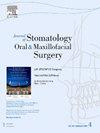在头颈部鳞状细胞癌中使用DNA含量作为患者分层和靶向治疗方法的见解:重新审视旧概念并探索新的可能性。
IF 2
3区 医学
Q2 DENTISTRY, ORAL SURGERY & MEDICINE
Journal of Stomatology Oral and Maxillofacial Surgery
Pub Date : 2025-01-23
DOI:10.1016/j.jormas.2025.102260
引用次数: 0
摘要
背景:本综述旨在强调DNA含量在头颈部鳞状细胞癌(HNSCC)中的意义,重点是其预测价值,在患者分层中的作用,以及作为这种恶性肿瘤的治疗靶点的潜力。方法:通过电子数据库检索对文献进行叙述性回顾。结果:在常规HNSCC中,非整倍体肿瘤与淋巴结转移增加、局部复发、放化疗反应差、预后差相关。很少有研究专门讨论DNA含量在年轻HNSCC患者中的作用。这些研究表明,与老年患者相比,年轻患者表现出较高的DNA含量异常,表明显着的基因组不稳定性和潜在的遗传差异。关于HPV和DNA含量,HPV相关肿瘤和HPV独立肿瘤之间没有发现差异。需要更多的研究来了解DNA含量在组织学亚型、手术边缘和靶向治疗中的作用。结论:本综述强调了HNSCC中与DNA含量相关的发现,提示其在患者分层和预后预测中的作用。本文章由计算机程序翻译,如有差异,请以英文原文为准。

Insights into the use of DNA content in head and neck squamous cell carcinoma as a method for patient stratification and targeted therapy: Revisiting old concepts and exploring new possibilities
Background
This review aimed to emphasize the implications of DNA content in head and neck squamous cell carcinoma (HNSCC), focusing on its predictive value, role in patient stratification, and potential as a therapeutic target for this malignancy.
Methods
A narrative review of the literature was conducted through electronic database searches.
Results
In conventional HNSCC, aneuploid tumors are associated with increased lymph node metastasis, locoregional recurrences, poor response to radiotherapy and chemotherapy, and worse prognosis. Few studies specifically address the role of DNA content in young HNSCC patients. These studies reveal that young patients exhibit high DNA content abnormalities, suggesting significant genomic instability and potential genetic differences compared to older patients. Regarding HPV and DNA content, no difference was found between HPV-associated and HPV-independent tumors. More research is needed to understand the role of DNA content in histological subtypes, surgical margins, and targeted therapy.
Conclusion
This review highlights the findings related to DNA content in HNSCC, suggesting its usefulness in patient stratification and outcome prediction.
求助全文
通过发布文献求助,成功后即可免费获取论文全文。
去求助
来源期刊

Journal of Stomatology Oral and Maxillofacial Surgery
Surgery, Dentistry, Oral Surgery and Medicine, Otorhinolaryngology and Facial Plastic Surgery
CiteScore
2.30
自引率
9.10%
发文量
0
审稿时长
23 days
 求助内容:
求助内容: 应助结果提醒方式:
应助结果提醒方式:


